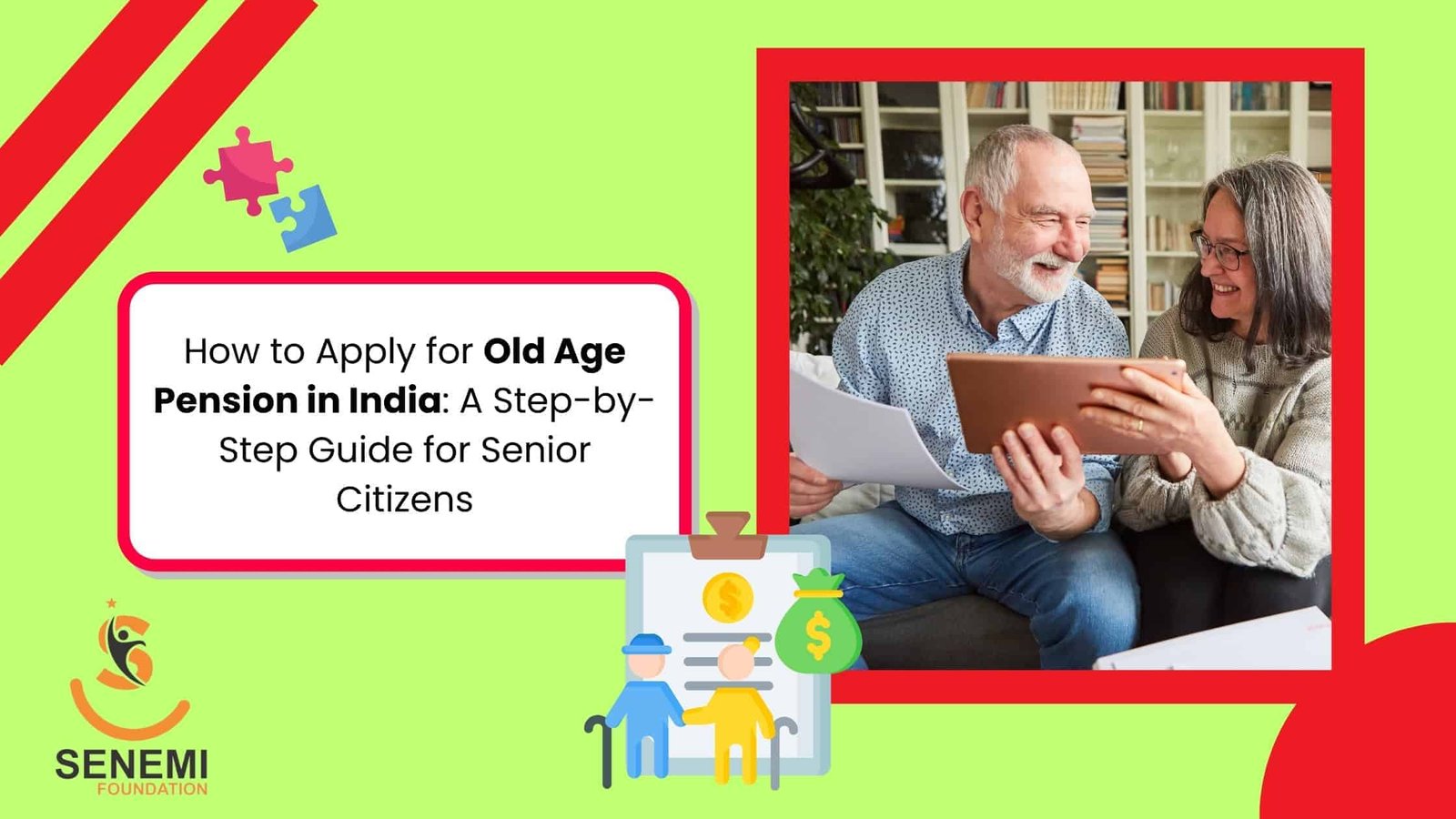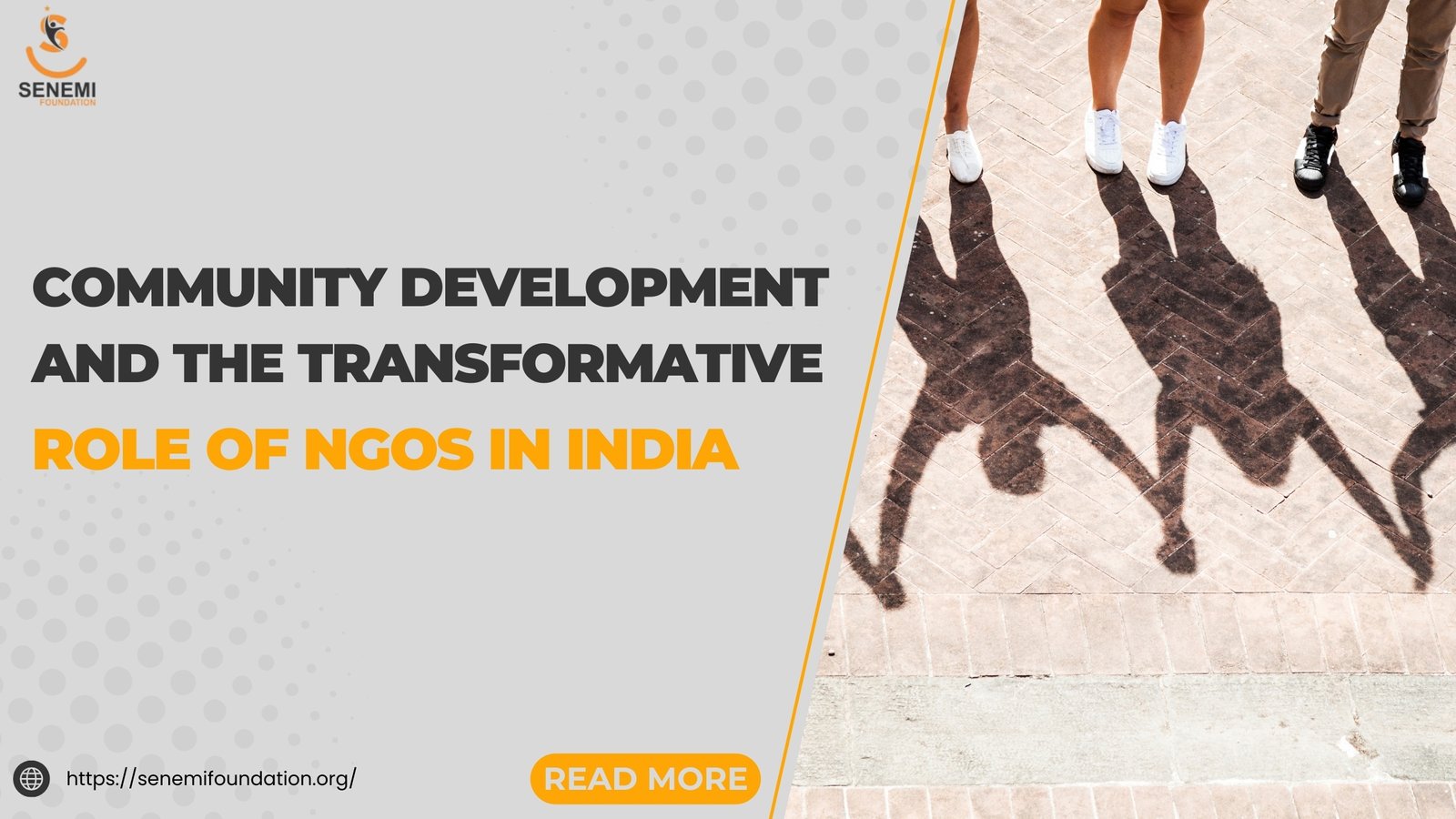

Introduction
Old age pension is a vital support system for senior citizens in India, offering financial assistance to help them lead a life of dignity and independence. With rising healthcare costs and limited income sources, government pension schemes act as a crucial safety net for the elderly. These schemes, run by both central and state governments, provide monthly financial aid to eligible individuals. However, many senior citizens and their families remain unaware of the benefits or struggle with the application process. This blog offers a clear, step-by-step guide on how to apply for old age pension and how NGOs like Senemi Foundation can assist.
Overview of Government Pension Schemes for Senior Citizens
India’s government has implemented several pension schemes to provide old age support for financially vulnerable senior citizens. These schemes are either centrally sponsored or operated by individual states to ensure no elderly person is left without basic financial security. Below is an overview of the most prominent ones:
Central Government Schemes
Indira Gandhi National Old Age Pension Scheme (IGNOAPS):
Under the National Social Assistance Programme (NSAP), IGNOAPS provides monthly pensions to senior citizens aged 60 and above who fall below the poverty line.
- Ages 60–79 receive ₹200/month
- Ages 80+ receive ₹500/month
The pension amount may be supplemented by state contributions, making the total monthly aid higher in some regions.
State-Level Initiatives
Several states have their own old age pension schemes, often with better benefits than the central scheme. Here are a few examples:
- Old Age Pension UP (Uttar Pradesh): Offers ₹1000/month to eligible senior citizens with provisions for online application and Aadhaar-linked status checks.
- Delhi Government Old Age Pension Scheme: Provides ₹2000–₹2500/month, with special benefits for widowed or disabled elderly persons.
- Other State Schemes: Rajasthan, Tamil Nadu, Maharashtra, and West Bengal also run state-specific pension programs with varying eligibility and disbursement rules.
These schemes collectively aim to ensure that senior citizen benefits reach the grassroots, especially in rural and underprivileged areas.
Eligibility Criteria for Old Age Pension in India
To access the benefits of an old age pension scheme, senior citizens must meet certain eligibility requirements. Although criteria may vary slightly between central and state-level schemes, the following are commonly required across most platforms:
Age Requirements
Most schemes require applicants to be:
- 60 years or older (some states may set the minimum at 65)
- Applicants must present age proof documents like a birth certificate, Aadhaar card, or school leaving certificate.
Income Threshold
- Applicants must belong to the Below Poverty Line (BPL) category or have a household income below a specified limit.
- Some states set an annual income cap (e.g., ₹1 lakh or ₹2 lakh per year).
- An income certificate issued by a competent authority, like a Tehsildar or SDM, is usually required.
Residency and Citizenship
- Applicants must be permanent residents of the state where they are applying for the pension.
- Must be Indian citizens.
- Documents like ration cards, voter ID, or utility bills are used as proof of residence.
These eligibility norms ensure that senior citizen benefits are reserved for the truly deserving and help channel government support to the most economically vulnerable elderly population.
Documents Required for Old Age Pension Application
Applying for an old age pension requires submission of valid documents to verify identity, age, income, and residence. Ensuring all paperwork is in order speeds up the pension application process and reduces the chances of rejection or delay.
1. Identity Proof
- Aadhaar Card (mandatory in most states)
- Voter ID
- PAN Card
These documents establish the applicant's identity and are essential for verification and DBT (Direct Benefit Transfer) processing.
2. Age Proof
- Birth Certificate
- School Leaving Certificate
- Aadhaar Card (used in many cases to verify age)
Since age is a critical criterion, having at least one valid proof is necessary.
3. Address Proof
- Ration Card
- Electricity or Water Bill
- Voter ID
- Aadhaar Card
These help verify the residency status in the concerned state.
4. Income Certificate
- Issued by Tehsildar, SDM, or local authorities
- Must confirm that the applicant’s income is below the prescribed threshold (varies by scheme/state)
5. Bank Account Details
- Bank Passbook Copy
- The account must be Aadhaar-seeded and active
- Pension is credited directly through DBT into the applicant’s account
6. Passport-size Photographs
- Typically 2–4 recent photos are needed during the application process.
Step-by-Step Pension Application Process
Applying for an old age pension can be simple if you follow the right steps and use the appropriate platform. Most states now offer online portals to make the pension application process easier, especially for senior citizens with limited mobility. Here's a detailed guide:
Step 1 – Visit the Official Portal
Each state has its own website for social welfare schemes. For example:
- Old Age Pension UP: https://sspy-up.gov.in
- Delhi Government Pension Portal: https://edistrict.delhigovt.nic.in
Search for “old age pension [your state]” to find the correct site.
Step 2 – Register and Create an Account
- Click on the relevant scheme (e.g., IGNOAPS, State Pension).
- Create a profile using your Aadhaar number and mobile number.
- Verify via OTP.
Step 3 – Fill Out the Application Form
You will be asked to enter:
- Personal details (name, date of birth, gender)
- Income details
- Aadhaar number
- Bank account details
- Upload scanned documents (age proof, income certificate, photographs, etc.)
Make sure all information is accurate and matches the documents.
Step 4 – Submit and Note the Application ID
- Submit the completed form.
- An application/reference number will be generated—this is important for tracking old age pension status later.
Step 5 – Verification by Authorities
- Local administrative officers (BDO, Tehsildar, etc.) verify your documents and eligibility.
- They may visit your home or contact you for clarifications.
Step 6 – Approval and Fund Disbursement
- Once approved, your name will be added to the old age pension list.
- The pension amount is transferred monthly to your Aadhaar-linked bank account under the Direct Benefit Transfer (DBT) system.
How to Check Old Age Pension Status Online
After submitting the application for an old age pension, it’s crucial to track its progress. Fortunately, most state governments in India offer simple ways to perform an old age pension status check online. Here’s how you can keep track of your pension application or payment status:
1. State-Wise Pension Status Check Portals
Each state has its own website where applicants can check their old age pension status using their application number or personal details. Here are a few examples:
- Uttar Pradesh: https://sspy-up.gov.in
Go to “Pensioners List” or “Application Status” section. - Delhi: https://edistrict.delhigovt.nic.in
Check under the “Track Your Application” tab.
You’ll need:
- Application/reference number OR
- Aadhaar number OR
- Registered mobile number
2. Old Age Pension Status Check by Aadhaar Card
Many portals now allow checking status using Aadhaar number:
- Enter your 12-digit Aadhaar number in the designated field.
- Complete the CAPTCHA.
- Click “Submit” to view the current status of your pension application or payment.
This method is user-friendly and doesn’t require login credentials.
3. Checking Name in the Old Age Pension List
Once approved, applicants’ names appear in the state pension beneficiary list, also called the old age pension list. To check:
- Visit the relevant portal.
- Select your district, block, and village/town.
- View the list sorted by applicant name or registration number.
Benefits of Applying for Old Age Pension
The old age pension scheme is more than just a monthly financial aid—it is a symbol of dignity, care, and social inclusion for senior citizens. For many elderly individuals living without a stable income, these schemes provide essential old age support that significantly improves their quality of life.
1. Monthly Financial Assistance
- Beneficiaries receive a fixed monthly amount ranging from ₹300 to ₹2500, depending on the scheme and state.
- The funds help cover basic necessities like food, medicine, and utilities.
- Payments are made directly to bank accounts via Direct Benefit Transfer (DBT), ensuring transparency.
2. Reduced Dependence on Family or Relatives
- With a steady income, seniors gain a sense of independence and self-worth.
- It reduces the financial burden on their families, especially in economically weak households.
3. Access to Additional Government Schemes
Old age pension recipients may also become eligible for other senior citizen benefits, including:
- Free or subsidized healthcare
- Concessional travel fares in buses or trains
- Priority in government schemes such as housing or ration distribution
4. Social Security and Emotional Well-Being
- Knowing that the government is providing support builds emotional security and trust.
- It helps fight feelings of neglect, isolation, and abandonment among the elderly, especially those living alone.
5. Legal and Government Recognition
- Being listed in the old age pension list gives elderly citizens an official acknowledgment of their rights and status.
- It opens doors to NGO assistance for elderly who may otherwise struggle with government formalities.
Receiving an old age pension can truly transform the lives of senior citizens, making them feel valued, protected, and financially secure in their twilight years.
Challenges Faced by Senior Citizens in the Pension Application Process
While the old age pension scheme is designed to be inclusive and accessible, many senior citizens still face multiple challenges when applying for benefits. These hurdles often prevent deserving individuals from receiving timely support and financial security.
1. Digital Divide
- Many elderly applicants, especially in rural areas, are not tech-savvy and find it difficult to navigate online portals.
- Lack of access to smartphones, internet connections, or cyber cafés further complicates the pension application process.
- Even if family members are willing to help, they may be unaware of the proper procedures.
2. Incomplete or Missing Documentation
- Many seniors, especially in remote regions, lack proper documents such as age proof, income certificates, or Aadhaar.
- Old or mismatched records lead to application rejections or prolonged verification delays.
- Generating income certificates can also be a hassle for those without clear proof of earnings.
3. Low Awareness of Government Schemes
- A large number of senior citizens are unaware of their entitlements under government pension schemes.
- They do not know how to apply, what documents are needed, or where to check their old age pension status.
- Misinformation and reliance on local middlemen often lead to exploitation or misguidance.
4. Bureaucratic Delays and Corruption
- Applications may get stuck in government offices due to red tape, slow processing, or clerical errors.
- In some regions, applicants may face demands for bribes or unofficial “fees” to speed up approvals.
- The process of correcting mistakes in submitted applications is time-consuming and frustrating.
5. Physical Limitations and Accessibility Issues
- Elderly individuals with limited mobility may find it hard to visit banks, government offices, or public service centers for follow-ups or document submissions.
- This often results in missed deadlines, rejections, or lapsed benefits.
These challenges highlight the need for NGO assistance for the elderly, digital literacy programs, and improved outreach to ensure every eligible senior citizen can avail the benefits of the old age pension scheme.
How NGOs Can Assist Senior Citizens in the Pension Process
With the growing demand for old age support, Non-Governmental Organizations (NGOs) play a crucial role in bridging the gap between senior citizens and the benefits offered by government pension schemes. These organizations bring community-level outreach, personalized assistance, and compassion to a process that can often feel overwhelming for the elderly.
1. Awareness Campaigns and Community Outreach
- NGOs organize door-to-door awareness drives, workshops, and camps to educate seniors about their rights and entitlements under various pension schemes.
- They distribute printed guides and explain the pension application process in local languages, ensuring seniors are well-informed.
2. Help with Documentation and Paperwork
- One of the major barriers for elderly applicants is collecting and organizing the necessary documents.
- NGOs assist with:
- Obtaining age and income certificates
- Linking Aadhaar to bank accounts
- Printing and filling out forms
This NGO assistance for the elderly reduces application errors and saves time.
3. Digital Assistance for Online Applications
- NGOs often set up help desks or mobile service units to assist with online registration and document uploads on official portals.
- This service is especially vital in rural or tribal areas where digital access is limited.
- Seniors are also trained on how to do old age pension status checks by themselves or with minimal help.
4. Grievance Redressal and Follow-Ups
- In cases where applications are delayed or rejected, NGOs intervene by:
- Communicating with local authorities
- Resubmitting documents if required
- Assisting with appeals
Their regular follow-ups ensure that elderly applicants are not lost in bureaucratic loops.
5. Emotional and Physical Support
- Beyond the paperwork, NGOs provide companionship and moral support during the application process.
- Volunteers often escort seniors to offices, help them with biometric verification, or explain complex rules in simple terms.
6. Building Trust in the System
- By acting as facilitators and advocates, NGOs help restore faith in government pension schemes.
- Seniors begin to see the system as supportive rather than intimidating.
In essence, NGOs become a lifeline for those who are vulnerable, alone, or uninformed. They ensure that the promise of old age pension turns into a reality for every eligible senior citizen.
How Senemi Foundation Helps Senior Citizens Get Old Age Pension
Senemi Foundation, recognized as one of the top NGOs in India, has been at the forefront of empowering elderly citizens by helping them access their rightful old age pension. With a grassroots presence, community trust, and a strong support team, the foundation ensures that no eligible senior is left behind due to lack of awareness, documents, or digital literacy.
1. Personalized Guidance for Every Senior
- The foundation assigns trained volunteers who offer one-on-one assistance to elderly applicants.
- From filling out forms to organizing necessary documents, every step of the pension application process is handled with care and patience.
2. Village-Level Help Desks and Digital Assistance
- Senemi Foundation runs local support centers in villages and small towns to help seniors:
- Apply online
- Upload documents
- Track their old age pension status
- These help desks are particularly beneficial in remote areas where seniors face connectivity and literacy challenges.
3. Collaboration with Government Authorities
- The foundation acts as a liaison between citizens and authorities, ensuring:
- Faster verification and approval
- Resolution of stuck or rejected applications
- Direct escalation of grievances
- This proactive approach increases the number of successful pension grants.
4. Home Visits for the Bedridden and Disabled
- For seniors who are immobile or seriously ill, Senemi Foundation offers home visit services to:
- Collect documents
- Complete Aadhaar verification
- Submit applications on their behalf
This initiative ensures no one is excluded due to physical limitations.
5. Follow-Up Support and Grievance Redressal
- Senemi Foundation keeps track of applications even after submission.
- They assist seniors in checking the old age pension status check by Aadhaar card, and help with follow-ups or appeals if needed.
- Regular contact is maintained until the pension is disbursed.
6. Holistic Senior Citizen Support Programs
- Beyond pensions, the Foundation provides access to:
- Healthcare camps
- Free ration kits
- Emotional counseling
- Legal aid
- This holistic model uplifts elderly lives across multiple dimensions—not just financially.
7. Real-Life Impact Stories
- Thousands of elderly individuals have benefited from Senemi’s intervention, many of whom were unaware of their rights.
- Stories of women in rural villages, widowers without family support, and seniors with disabilities now receiving pensions serve as powerful testaments to the foundation’s mission.
Senemi Foundation stands as a beacon of hope for India’s elderly population, ensuring that the right to dignity, security, and government support is not a privilege, but a reality for all.
Conclusion
Accessing an old age pension is not just about receiving financial aid—it is about ensuring that senior citizens live with dignity, security, and the respect they deserve. Despite the availability of robust government pension schemes, many eligible individuals miss out due to a lack of awareness, documentation challenges, or digital barriers. This is where the role of NGOs becomes crucial.
From understanding eligibility to guiding seniors through the pension application process, and from checking the old age pension status to resolving grievances, organizations like Senemi Foundation are making a transformative impact. With personalized support, on-ground presence, and a deep understanding of government systems, Senemi ensures that no senior is left behind.
 Deepak
Deepak









